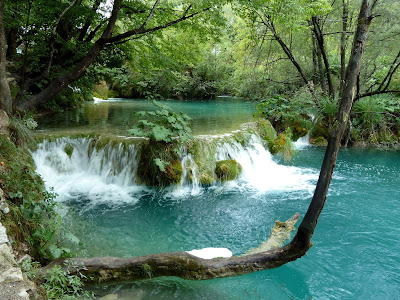Plitvice Lakes National Park
Is one of the oldest national park in Croatia. In 1979, Plitvice Lakes National Park was added to the UNESCO World Heritage register. Contains a series of beautiful lakes, caves and waterfalls. These have been formed by processes typical of karst landscapes such as the deposition of travertine barriers, creating natural dams. These geological processes continue today.
 |
| Plitvice lakes |
The waters flowing over the limestone and chalk have, over thousands of years, deposited travertine barriers, creating natural dams which in turn have created a series of beautiful lakes, caves and waterfalls. These geological processes continue today. The forests in the park are home to bears, wolves and many rare bird species.
History
The national park was founded in 1949 and is situated in the mountainous karst area of central Croatia, at the border to Bosnia and Herzegovina. The important north-south road connection, which passes through the national park area, connects the Croatian inland with the Adriatic coastal region.
The protected area extends over 296.85 Km2. About 90% of this area is part of Lika-Senj County, while the remaining 10% is part of Karlovac County.
Each year, more than 1.1 million visitors are recorded. Entrance is subject to variable charges, up to 180 kuna or around $32 USD per adult in peak season. Strict regulations apply.
Descriptions
The national park is world famous for its lakes arranged in cascades. Currently, 16 lakes can be seen from the surface. These lakes are a result of the confluence of several small rivers and subterranean karst rivers. The lakes are all interconnected and follow the water flow. They are separated by natural dams of travertine, which is deposited by the action of moss, algae, and bacteria. The particularly sensitive travertine barriers are the result of an interplay beween water, air and plants.
The Plitvice Lakes basin is a geomorphologic formation of biological origin, a Karst river basin of limestone and dolomite, with approximately 20 lakes, created by the deposition of calcium carbonate precipitated in water through the agency of moss, algae and aquatic bacteria. These create strange , characteristic shapes and contain travertine-roofed and vaulted caves. In order to maintain and preserve the natural characteristics of the lakes, the whole of surface and most of the subterranean drainage system has to be embraced by extending the original borders of the park. The new areas comprise layers of karstified limestone with dolomites to Jurassic age.
There are 16 interlinked lakes between Mala Kapela Mountain and Pljesevica Mountain. The lake system is divided into the upper and lower lakes: the upper lakes lie in a dolomite valley and are surrounded by thick forests and interlinked by numerous waterfalls; the lower lakes, smaller and shallower, lie on the limestone bedrock and are surrounded only by sparse underbrush. The upper lakes are separated by dolomite barriers, which grow with the formation of travertine, forming thus travertine barriers. Travertine is mostly formed on the spots where water falls from and elevation, by the incrustation of algae and moss with calcium carbonate. the lower lakes were formed by crumbling and caving in of the vaults above subterraneam cavities through which water of the upper lakes disappeared.
Flora, fauna and others things.
The forest, that comprises pure stands of beech at lower altitudes and mixed stands of beech and fir at higher levels, can also be classified in terms of underlying strata of dolomite and limestone complexes. The dolomite communities comprise tertiary pine. hornbean, spruce and beech- fir forest. The limestone communities have a smaller number of forests types but cover a larger area with communities of spruce and fern, spruce in beech, coppiced hornbeam with sumac, maple and heather. Hydrophytic communities
of black alder, grey ivy, willow, reeds and bulrush communities are found.
There are a large mosaic of meadow communities, depending on altitude, geology
soils and other ecological factors.
The area is
fauna-rich, including European brown bear, wolf, eagle owl and capercaillie.
There are records of 126 species of bird, of which 70 breed.
The area
was the cradle of the prehistoric Illyrian tribe of Japuds dating from 1000 BC.
The Japudic culture was followed by the Romans and from the 8th century AD was
occupied by Slavs. Archaeological remains include a prehistoric settlement on
the site of the current Plitvice village, fortifications, Bronze Age tools and
ceramics.
For more information visit de official page: Plitvice Lakes
Thank´s for your visit, please comment and share this.





No comments:
Post a Comment